Dana Lee, FishBio
This blog from FishBio was originally posted on April 17, 2023.
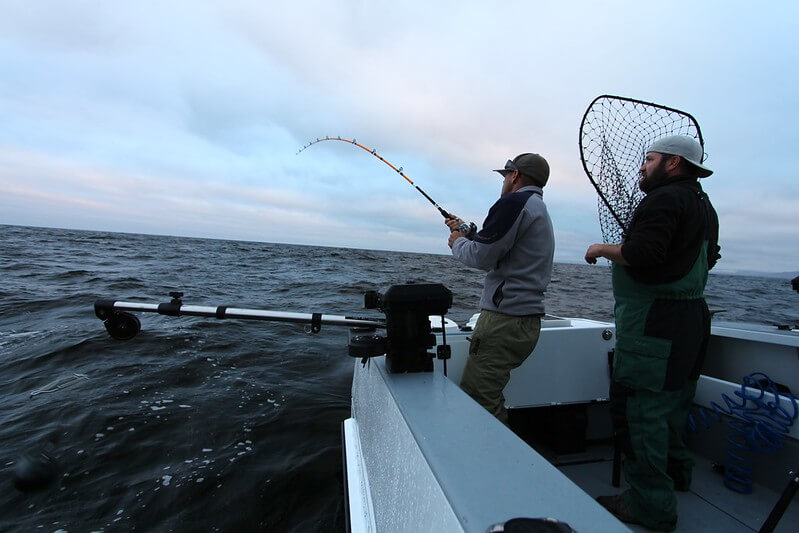
Last week’s Fish Report covered the disappointing news about this year’s salmon fishery closure as well as some of the alarming predictions for the coming year. However, each year, it is important to look back and review some of the key findings from the previous year’s salmon population. Despite a productive fishery, the overall 2022 salmon population continued the downward trend from the previous few years. Ultimately, escapement totals, or the total number of salmon that “escaped” the fishery and returned to the Central Valley to spawn the next generation, were some of the lowest on record. Information on the annual salmon population is collected and published in a series of reports each year by the Pacific Fishery Management Council (PFMC). The reports provide details on the previous year’s salmon fisheries along the West Coast, detailing harvest and escapement totals as well as the fishery’s socioeconomic benefits. They also include information on how preseason predictions were used to set harvest regulations prior to the start of the year, allowing for comparisons between the predicted and final population estimates. Inaccurate preseason predictions can have severe consequences: an underestimation can impose unnecessary restrictions on the commercial fishery, and an overestimation can lead to reduced escapement and low numbers of fish available for in-river recreational fishing. Since 2005, Central Valley salmon abundance has been overestimated more than three-quarters of the time, which continues to hamper effective management of the fishery. In 2022, the population was overestimated once again with an actual population that was 37% lower than forecasted.
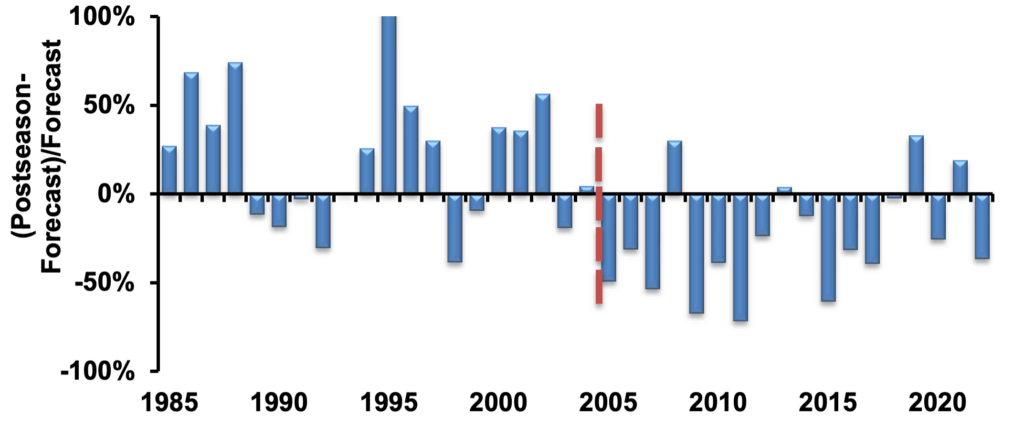
Percent difference from PFMC average annual preseason forecast relative to the actual SI observed, 1985-2022. Source: PFMC 2023a
In California, harvest and escapement targets are largely focused on Sacramento River fall-run Chinook salmon, as this population contributes the majority of fish that make up the harvest and escapement totals. The PFMC uses the Sacramento Index (SI), a metric based on fishing regulations and quotas that represents the total number of adult fish (ages 3-5) projected to be available in the ocean the coming year that will either escape or be harvested. The preseason forecast for 2022 was among the highest in recent years with an expected SI of 396,458 fish and a total projected spawning escapement of 198,694 hatchery and natural area spawners. However, by the end of the 2022 season, PFMC reported an estimated SI of only 251,191 fish, which is a 22% decline from last year, and 16% lower than the previous five-year average of 298,500 fish. Given a lack of in-season management for salmon in California, this inaccurate pre-season forecast led to an exploitation rate (i.e., the percentage of fish that were commercially harvested) of 75%, which was the highest exploitation rate since 2004. As a result, escapement to Central Valley rivers was severely depressed, with implications on the number of juveniles migrating to the ocean this spring and the future returns of adult salmon.
In 2022, an estimated 61,850 fall-run Chinook salmon “escaped” the harvest and spawned in hatcheries and natural areas of the Sacramento River Basin. This escapement number was well below the long-term management goal of 122,000 hatchery and natural area spawners, and 69% lower than the preseason forecast (Figure 2). The natural-area spawners (32,712) exceeded that of hatchery returns (29,138), which is common in most years, but is sometimes reversed in low-escapement years such as in 2017 (Figure 3). However, it is likely that hatchery-origin fish also comprise a large percentage of the natural area spawners. Despite the low escapement and high exploitation rates, the stock is not considered overfished at this time because the current three-year average (2020, 2021, and 2022) spawning escapement (96,613) is above the minimum stock size threshold of 91,500.
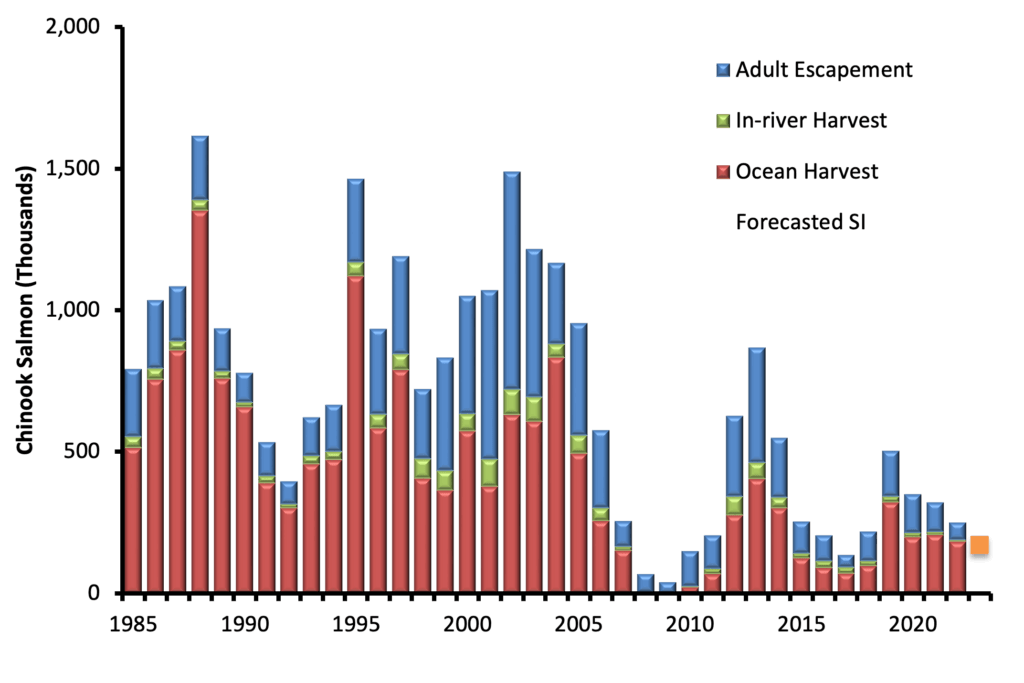
Sacramento River Fall-run Chinook salmon ocean harvest, river harvest, and escapement, 1985-2022. Source: PFMC 2021a; 2023b
While survival in the San Joaquin Basin is generally much lower than in the Sacramento River Basin, salmon returns to the San Joaquin River Basin increased by 40% over 2021, with a total estimated escapement of 8,120 salmon or 14% of the entire Central Valley total. For perspective, the San Joaquin Basin has historically constituted less than 10% of the total Central Valley escapement. However, since 2015 the San Joaquin contribution has exceeded 10% every year, with an average contribution of 14%. A total of 4,538 fall-run Chinook salmon returned to natural areas of the San Joaquin Basin, and 3,582 salmon returned to Mokelumne and Merced River hatcheries combined. Much like the Sacramento Basin, it is likely that hatchery-origin fish also comprise a large percentage of the natural area spawners in the San Joaquin Basin. It is not clear why the proportion of escapement has been relatively high in the San Joaquin Basin over the past few years, but this may be due in part to decreased populations in the Sacramento Basin following the drought, as well as increased trucking and release of hatchery smolts at off-site locations resulting in increased straying of returning adults from other basins.
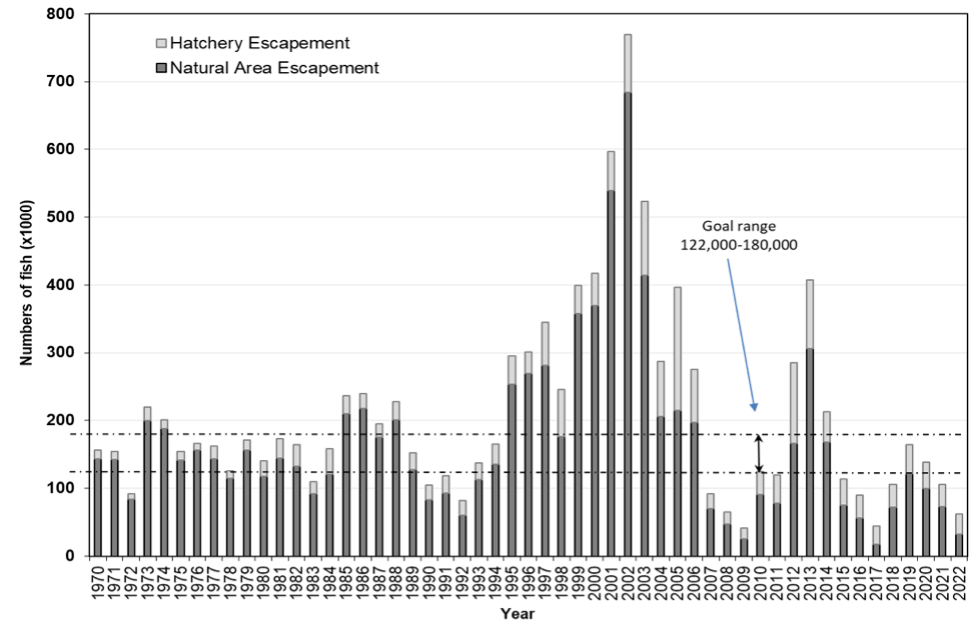
Sacramento River adult fall-run Chinook escapement 1970-2022. Source: PFMC 2023a.
The commercial fishery harvest in 2022 continued to rebound from the historically low numbers of the previous few years, with landings revenues (coastwide ex-vessel value, price received at the dock) of $17.1 million. This total was 21% higher than the 2017-2021 average of $16.4 million (Figure 4), but 58% below the 1979-1990 inflation-adjusted average of $40.5 million (which included coho salmon landings during that period). The 2022 commercial catch of 211,186 fish represented a slight increase over the previous year and a 37% increase over the 2017-2021 average of 154,497 commercially caught salmon. Commercial fishing effort (boat days fished) more than doubled to 15,774 after remaining steady for three consecutive years. The average California ex-vessel price for troll-caught Chinook salmon continued to decrease from recent highs to $7.51 per pound (Figure 4). In 2022, across the entire Pacific Coast (excluding Alaska), the highest commercial Chinook landings by weight were recorded at San Francisco (53%), Monterey (18%), and Fort Bragg (8%), followed by several ports in Oregon and Washington. Since 2019, between 79-85% of the Pacific Coast commercial Chinook landings by weight were landed in these three ports, which historically comprised only ~40% of the total coastwide landings. It is unclear why commercial landings at these ports have been relatively higher in recent years, but given that the harvest has remained fairly stable in California since 2019, it likely points to struggling salmon populations coastwide.
The 2022 recreational ocean salmon catch continued the upward trend from prior years, with a total harvest of 88,961 Chinook salmon, which is the highest catch since 2013, and a 33% increase over the previous five-year average (66,732). Recreational harvest of fall-run Chinook salmon in the Sacramento River and its tributaries totaled only 4,860 fish, after a forecasted harvest of 32,345.
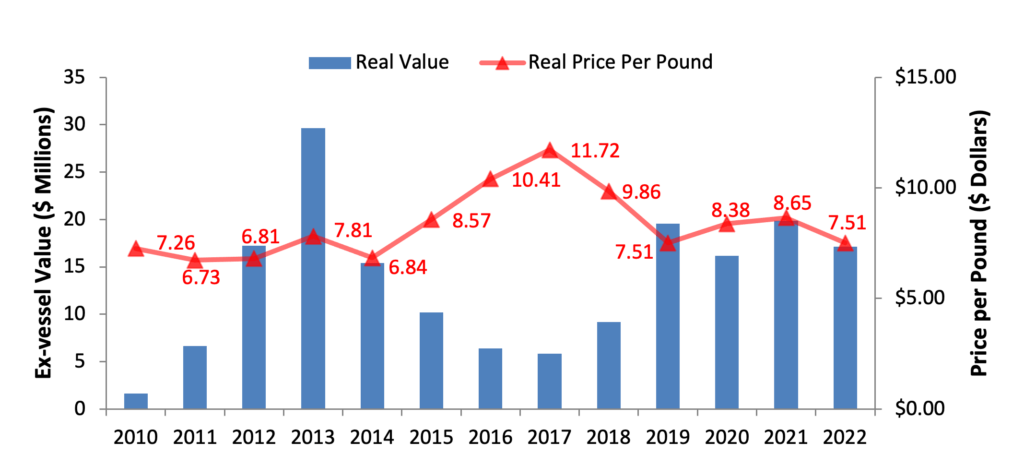
Commercial ex-vessel value and price per pound 2010-2022. Source: PFMC 2023a.
Unfortunately, anglers received unwelcome news from PFMC this year, with reduced forecasts leading to the first fishery closure since 2008-2009. If preseason forecasts are correct, there will be 169,767 Sacramento River fall-run Chinook salmon in the ocean this year. This forecast is 57% less than last year’s prediction and 51% lower than the average predictions of the previous five years (358,248). In the near future, California will suffer the economic and ecological consequences of a closed fishery and reduced salmon returns in the Central Valley. Drought has played a leading role in the last few years, dwindling California salmon populations. However, the recent and abnormal winter full of atmospheric rivers brings a wave of hope for salmon.



